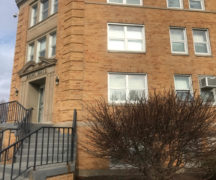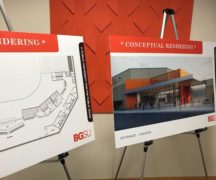By DAVID DUPONT
BG Independent News
Betty Montgomery, chair of the Bowling Green State University board of Trustees, made an unusual request at Friday’s meeting.
She asked for “a moment for the chair to give one wahoo for the next item.”
That item called for the appropriation of $1,925,933 for the demolition of the Administration Building. The project has been talked about for years as the university has renovated buildings around what is now the Bowen-Thompson Quadrangle as well as razing West Hall and the Family and Consumer Science buildings.
Removing the 10-story structure, which was built in 1961 and sits on the west end of the quadrangle, will open up the campus and provide a new view into campus.
President Rodney Rogers said the building has significant problems, including not being in compliance with the Americans with Disabilities Act. “It does not meet the needs of today.”
A planned new entrance is not part of the project approved. That will be presented at a later date.
Sheri Stoll, the university’s chief financial officer, told trustees during the financial affairs committee meeting Thursday that the work will begin in fall 2021.
Several offices still in the building, including bursar and the Office of Marketing and Brand Strategy still need to be relocated, and some abatement work inside needs to be done before the demolition begins. The job is expected to be completed in late fall 2022.
New home for construction management
The board also approved further expansion of the Park Avenue Building, which now houses the architecture program.
The board had already approved spending $5.2 million for “a modest addition” to the building to provide space for the construction management program. Construction has not started yet. That money was coming from $10.4 million appropriated to renovate the Technology Building.
Stoll said that, on studying the program, it was decided that more room was needed for construction management. Now the entire amount intended for the Technology Building will be used to increase the building by another 10,000-13,000 feet, more than doubling the size of the original plan.
April Smucker, associate vice president for Capital Planning and Campus Operations, said the work will begin this summer and be completed in fall 2022.
Stoll said that the decision was made so the entirety of construction management could be in one building.
Together construction management and architecture make up the School of the Built Environment. Having them under one roof increases the synergies between the programs, which are its strength and its distinguishing feature.
When graduates go into the real world, Stoll said, the construction managers and architects know how to work together.
This allows the School of Built Environment “to be all it can be.”
The current state capital budget has appropriated $16.7 million for the construction of a new home for the College of Technology, Architecture and Applied Engineering.
BGSU takes a hit in residential & meals revenue
In other business, the trustees set room and meal rates for the incoming first year class. Because of the Falcon Guarantee, students pay the same for the four years they are on campus, so this will only apply to students in the class of 2025.
The cost of a standard double room will increase by 2 percent, or $60 a year, to $3,085. That’s the rate the university must report to the state. The increases vary based on the room configuration, with the increase averaging 1.8 percent.
Stoll said that as an auxiliary unit, Residence Life relies on room fees to cover expenses, financing, upkeep, and needed improvements.
The rates are set in part, she said, by surveying the rates being charged for rental properties in the community.
This year, the dorms have been de-densified, with most students in singles with only those who mutually agree being allowed to occupy doubles. Occupancy has been just over 50 percent, going from the usual 6,000 residential students to 3,600 in fall and 3,200 in spring.
That will represent a loss of $6 million to $9 million in addition to the $8.7 million in housing refunds given in the spring of 2020 when students were sent home at the onset of the pandemic.
Some of this will be recouped from federal CARES funds, but how much is unknown.
Despite what is done next year, Stoll expects occupancy in residence halls to remain low.
Students are required to live in residence halls, unless they live at home, in their first and second years. However, students who were encouraged to live off-campus as first year students as part of the university’s effort to have fewer students living on campus will not be required to live in residence halls as sophomores.
She doesn’t expect occupancy to rebound until fall 2023.
A similar situation exists for University Dining Services. Losses in revenue and because of refunds amounted to $8 million. That includes $580,000 in refunds given to students this semester because so many dining facilities were closed because employees had contracted or had been exposed to COVID-19.
Meal plans for the incoming class will be 3 percent higher. That makes the Bronze Plan $1,860 a semester, or $54 more.
The Community Plan will also increase by 3 percent to $352, or $10. This plan is available for off-campus students, staff, faculty, and the community.
Again, rates need to cover the cost of feeding students as well as any further maintenance and upgrades to the facilities.
Also, Stoll said, inflation in the cost of food has to be considered. Particularly an increase in the cost of meat can have a sudden and significant impact.
The trustees also approved:
- $548,680 for design work in preparation for a major upgrade of its information technology infrastructure.
- $1,287,239 for exterior work on Falcon Heights and Centennial residence halls, which opened in 2011.





